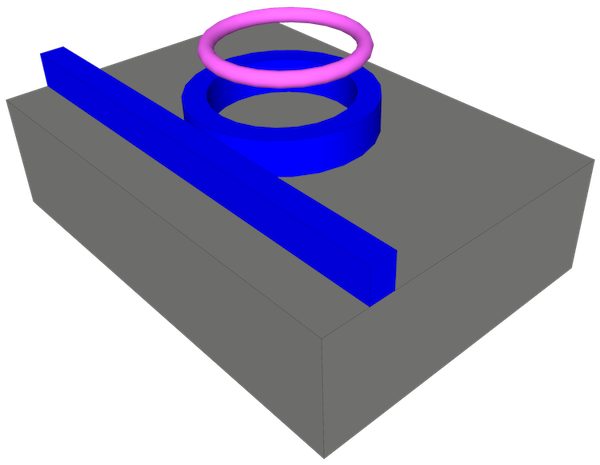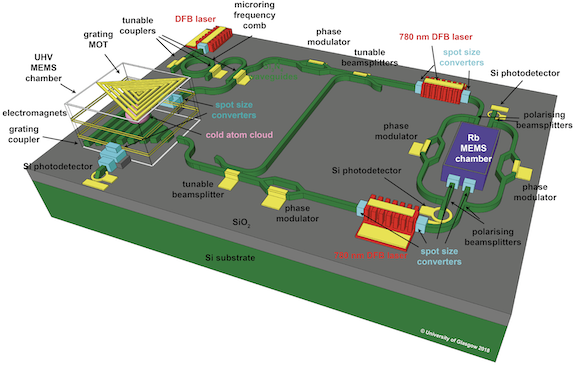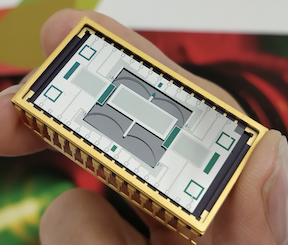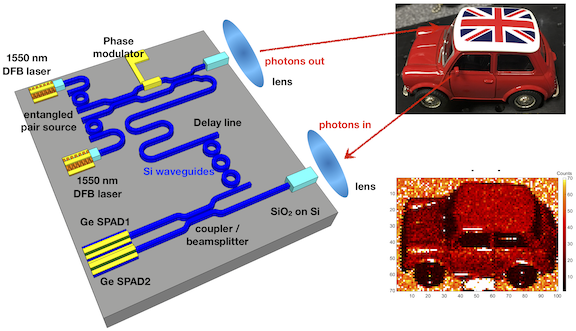PhD Projects Available
PhD Studentships
Doug is always keen to find high quality PhD students for any of the funded areas in the group and has full PhD funded positions available for UK students. The group has also had a number of students with prestigious PhD scholarships and is happy to support scholarship applications from excellent students. If you are interested in undertaking a PhD related to any of the topics discussed in the web pages, please contact Prof Paul.

Cold atoms are produced by shining laser light of specific wavelengths onto atoms so that the momentum of the absorbed photons slows the atoms. As the temperature of the atoms is proportional to the square of the velocity of atoms, the atoms are cooled and can be cooled to microKelvin temperatures. The cooling reduces the frequency uncertainty of the atomic transitions allowing more accurate atomic clocks and sensors to be produced. Most experiments use complicated optical set ups in large vacuum chambers to enable the cooling of atoms from a thermal gas cloud. These large laboratory systems have demonstrated high performance atomic clocks, accelerometers, gravimeters and gyroscopes but are too large and impractical for most real world applications.
This project aims to develop chip scale atomic traps using waveguides and photonic integrated circuits to control light that can trap atoms on silicon chips. Red detuned light from atomic transitions of the outer electron in alkali atoms attracts atoms whilst blue detuned light will repeal atoms. By using both red and blue detuned light, a potential well trap for atoms can be produced. This project aims to use red and blue detuned light in the evanescent tail of a waveguide to trap atoms a few 100s nm away from a waveguide on a photonic integrated circuit. MEMS microfluidic channels will be integrated to the chips to aid pre-cooling the atoms to enable more efficient atomic traps.
The work will be supervised by Prof Douglas Paul as part of a prestigious Royal Academy of Engineering Chair in Emerging Technologies and an EPSRC Programme Grant "Chip-scale atomic systems for a quantum navigator" aiming to deliver a quantum navigator that could fit inside a mobile phone. The work will include being trained in the micro- and nano-fabrication of devices in the James Watt Nanofabrication Centre cleanroom combined with simulation and full characterisation of the devices using electronic and optical techniques. The successful student will be working in a research group with access to the top researchers in academia and industry from the UK Quantum Technology programme and internationally through collaborations. They will also be able to present their work at some of the top international conferences in quantum technology.
The highly motivated student should have a first class or upper second class undergraduate degree in physics, engineering, photonics, nanotechnology, materials science or an equivalent degree from a reputable university. Background knowledge of semiconductors and optics / photonics would be beneficial but is not essential. No prior nano-fabrication experience is required - you will be fully trained during the PhD. You must be self-motivated, have good interpersonal skills, and be interested in conducting interdisciplinary work that combines theory, simulation, fabrication and characterisation. They will design and simulate atomic traps, fabricate them in the James Watt Nanofabrication Centre cleanroom and undertake testing to determine the performance.
The skills acquired during the PhD will make the student highly employable in the developing quantum technology field globally where there is already a significant and growing demand for suitably qualified expert people. Previous PhD graduate students of Prof Paul hold a range of research fellowships, senior academic positions as well as senior positions in companies including ARM, ASML, Kelvin Nanotechnology, Sivers Photonics, Vector Photonics, Smart Photonics, Dixons Carphone, patent lawyers and multiple financial investment companies.
How to Apply: Please refer to the following website for details on how to apply:
https://www.gla.ac.uk/postgraduate/research/electronicsnanoscale/
Scholarships for fees and stipends: https://frontdoor.spa.gla.ac.uk/ScholarshipApp/

The project aims to combining miniature diode lasers, photonic integrated circuits and MEMS vapour cells with atoms in a gas to develop a chip-scale optical atomic clock. By locking the frequency of a narrow-linewidth diode laser output to an atomic transition from shining the laser light through a gas of atoms, the frequency can be made extremely stable which provides long term timing accuracy since time is 1/frequency. A frequency comb is then used to take the stable optical signal and down-convert this to an electrical output at MHz or GHz through the beat frequency from interference defined by the path length of a microring optical resonator. The project aims to develop microfabricated versions of all these components and heterogeneously integrate them together into a single-chip optical atomic clock.
Most of our timing that society depends on for running critical national infrastructure (utilities, communications, navigation, etc...) comes from GPS satellite signals but these are easy to jam or spoof with a London Economics estimating a potential loss of £7.6Bn to the UK economy over 3 days if they were disrupted as stated in the UK National Risk Register 2023. Hold over clocks with sufficient accuracy and stability are therefore required but at present these are too large and expensive. While far cheaper chip scale atomic clocks are commercially available, their accuracy is only about 1 microsecond/day whilst many critical national infrastructure applications requires 1 nanosecond/day accuracy. Recently optical atomic clocks have been demonstrated in laboratories which have nanosecond/day accuracies but to date have been large and composed of discrete components on optics benches. This project aims to reduce the size, weight, power and cost of such optical atomic clocks for practical applications including navigation, telecoms and utility distribution.
The work will be supervised by Prof Douglas Paul as part of a prestigious Royal Academy of Engineering Chair in Emerging Technologies and an EPSRC Programme Grant "Chip-scale atomic systems for a quantum navigator" aiming to deliver a quantum navigator that could fit inside a mobile phone. The work will include being trained in the micro- and nano-fabrication of devices in the James Watt Nanofabrication Centre cleanroom combined with simulation and full characterisation of the devices using electronic and optical techniques. The successful student will be working in a research group with access to the top researchers in academia and industry from the UK Quantum Technology programme and internationally through collaborations. They will also be able to present their work at some of the top international conferences in quantum technology.
The highly motivated student should have a first class or upper second class undergraduate degree in physics, engineering, photonics, nanotechnology, materials science or an equivalent degree from a reputable university. Background knowledge of semiconductors and optics / photonics would be beneficial but is not essential. No prior nano-fabrication experience is required - you will be fully trained during the PhD. You must be self-motivated, have good interpersonal skills, and be interested in conducting interdisciplinary work that combines theory, simulation, fabrication and characterisation. They will design and simulate atomic traps, fabricate them in the James Watt Nanofabrication Centre cleanroom and undertake testing to determine the performance.
The skills acquired during the PhD will make the student highly employable in the developing quantum technology field globally where there is already a significant and growing demand for suitably qualified expert people. Previous PhD graduate students of Prof Paul hold a range of research fellowships, senior academic positions as well as senior positions in companies including ARM, ASML, Kelvin Nanotechnology, Sivers Photonics, Vector Photonics, Smart Photonics, Dixons Carphone, patent lawyers and multiple financial investment companies.
How to Apply: Please refer to the following website for details on how to apply:
https://www.gla.ac.uk/postgraduate/research/electronicsnanoscale/
Scholarships for fees and stipends: https://frontdoor.spa.gla.ac.uk/ScholarshipApp/

Glasgow has pioneered the use of MEMS devices for the measurement of gravity after demonstrating the first gravimeter that could measure the Earth tides (the gravitational force of the moon orbiting the earth) using a MEMS devices [1][2]. The approach used a novel geometrical anti-spring which unlike a Hooke's law spring, has the flexures getting softer as the proof mass is displaced away from the null point. The MEMS gravimeters are called wee-g, a pun on the Glaswegian dialect weegie for a Glaswegian. This approach allowed wee-g MEMS gravimeters to be produced using similar microfabrication techniques to the accelerometers in airbags and mobile phones but with 50,000 higher sensitivity. The sensitivity is high enough to be able to measure the gravitation force of a person within a metre distance.
This project aims to combine two geometrical anti-spring devices on a single piece of silicon and undertake common mode rejection to allow the gravity gradient to be measured. The present wee-g gravimeter is a single mass on a spring device and as such is susceptible to vibrations making it difficult to use on moving platforms. By producing a gradiometer, vibration will be predominantly removed by the common mode rejection allowing the gradiometer to be used on moving platforms such as vehicles, ships, aircraft, satellites and drones.
The work will be supervised by Prof Douglas Paul and Prof Giles Hammond as part of the UK Hub for Quantum Enabled Position Navigation and Timing. The work will include being trained in the micro- and nano-fabrication of devices in the James Watt Nanofabrication Centre cleanroom combined with simulation and full characterisation of the devices using electronic and optical techniques. The successful student will be working in a research group with access to the top researchers in academia and industry from the UK Quantum Technology programme and internationally through collaborations. They will also be able to present their work at some of the top international conferences in quantum technology.
The highly motivated student should have a first class or upper second class undergraduate degree in physics, engineering, photonics, nanotechnology, materials science or an equivalent degree from a reputable university. Background knowledge of semiconductors, MEMS and gravitywould be beneficial but is not essential. No prior nano-fabrication experience is required - you will be fully trained during the PhD. You must be self-motivated, have good interpersonal skills, and be interested in conducting interdisciplinary work that combines theory, simulation, fabrication and characterisation. They will design and simulate MEMS gradiometers, fabricate them in the James Watt Nanofabrication Centre cleanroom and undertake testing to determine the performance.
The skills acquired during the PhD will make the student highly employable in the developing quantum technology field globally where there is already a significant and growing demand for suitably qualified expert people. Previous PhD graduate students of Prof Paul hold a range of research fellowships, senior academic positions as well as senior positions in companies including ARM, ASML, Kelvin Nanotechnology, Sivers Photonics, Vector Photonics, Smart Photonics, Dixons Carphone, patent lawyers and multiple financial investment companies.
[1] "Measurement of Acceleration" GB patent GB1415087.4, US patent US20170276697, Canada patent number CA2959203, European patent EP3186664, Japan patent JP2017526919.
[2] R. Middlemiss et al., "Measurement of the Earth tides with a MEMS gravimeter" Nature 531, 614 (2016)
How to Apply: Please refer to the following website for details on how to apply:
https://www.gla.ac.uk/postgraduate/research/electronicsnanoscale/
Scholarships for fees and stipends: https://frontdoor.spa.gla.ac.uk/ScholarshipApp/

The James Watt School of Engineering at the University of Glasgow has a fully paid PhD scholarships (both fees and stipend for any UK or EC national) available for a quantum lidar project The quantum lidar project is linked to the UK Quantum Technology Hub for Quantum Enhanced Imaging (QuantiC) and an InnovateUK industrial programme developing lidar systems for automotive vehicles with partners including Toshiba Research Europe, IQE, Thales and Jaguar Land Rover. The successful candidates will be trained to use the James Watt Nanofabrication Centre, a 1500 m
Successful candidates are expected to have a first or upper second class degree from a reputable university in physics, electrical and electronic engineering, photonics, materials science or a suitably aligned degree. All the projects include design, modelling, fabrication and characterisation of photonic devices and systems. The students will also be expected to fully engaged with the UK Quantum Technology Programme and Hubs.
Quantum lidar / rangefinder: Glasgow has recently demonstrated world leading Ge on Si single photon avalanche detectors (SPADs) at 1500 nm wavelength with 38% single photon detection efficiency (Nature Comms. 10, 1086 (2019)). This project aims to developed waveguide coupled Ge on Si SPADs predicted to have >70% efficiency integrated into an interferometer with Si microring entangle photon sources (Nature Comms. 6, 7948 (2015)) to enable chip scale quantum lidar / rangefinders to be produced and tested.
How to Apply: Please refer to the following website for details on how to apply:
https://www.gla.ac.uk/postgraduate/research/electronicsnanoscale/
Scholarships for fees and stipends: https://frontdoor.spa.gla.ac.uk/ScholarshipApp/


